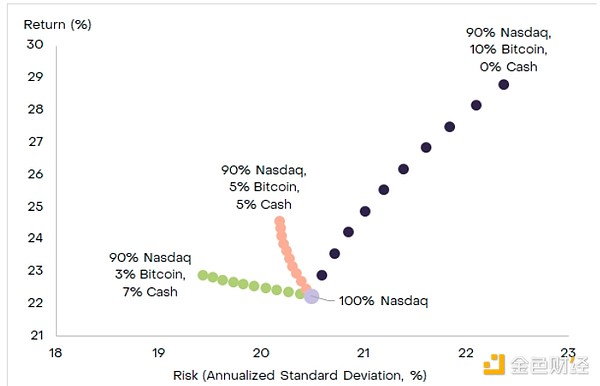Source: Grayscale; Compiled by Wuzhu, Golden Finance
Stocks in the Nasdaq 100 Index and Bitcoin are completely different but complementary investment portfolios. The Nasdaq 100 Index includes the largest non-financial stocks listed on the tech-heavy Nasdaq exchange. Bitcoin is the first public blockchain and is now the largest crypto asset by market capitalization. [1] Both the Nasdaq 100 and Bitcoin can be viewed as high-growth investments at the forefront of the digital transformation of the economy. Replacing a portion of Nasdaq-100 stock exposure with Bitcoin in a portfolio would allow investors to reduce U.S. equity concentration risk and could help optimize risk-adjusted returns.
Nasdaq 100 returns and Bitcoin returns have a moderate correlation, with a significant difference in volatility. The correlation between Bitcoin’s monthly returns and the Nasdaq 100’s returns has been about 40% since 2019 (Figure 1). Meanwhile, the annualized volatility of Bitcoin’s returns is 71.5%, while the annualized volatility of the Nasdaq 100 Index is 20.5%. However, investors who hold on for many years generally compensate Bitcoin's higher risk with higher returns. During this period, Bitcoin’s cumulative returns were almost 10 times higher: the Nasdaq 100 index rose about 3 times, while the price of Bitcoin rose about 30 times. Both Bitcoin and the Nasdaq 100 have a Sharpe ratio of 1.0. [2]
Figure 1: Since 2019, Bitcoin has a correlation of ~40% with the Nasdaq and outperformed by ~10x

Given these characteristics, in a portfolio with a Nasdaq 100 position, an allocation to Bitcoin and cash could potentially be used to increase expected returns, reduce risk without sacrificing expected returns, or move beyond the “efficient frontier” — that is, achieving higher expected returns without increasing volatility. As a hypothetical example, let’s consider here the potential impact on a portfolio of moving a 10% allocation from the Nasdaq 100 to a combination of Bitcoin and cash. [3]
Bitcoin may increase expected returns. The Nasdaq 100 has an annualized return of 22.2% since 2019, annualized volatility of 20.5%, and a Sharpe ratio of 1.0. Assuming a portfolio with 90% allocated to the Nasdaq 100 Index and 10% allocated to Bitcoin, the annualized return is 28.8%, the annualized volatility is 22.4%, and the Sharpe ratio is 1.2 (Exhibit 2). In other words, a Bitcoin allocation would shift the portfolio toward a higher risk and return mix, with some diversification benefits and a slightly higher Sharpe ratio.
Bitcoin reduces risk without sacrificing expected returns. Alternatively, we could consider a portfolio allocated to both Bitcoin and cash to reflect Bitcoin’s higher volatility. For example, since 2019, a hypothetical portfolio allocated 90% to the Nasdaq 100, 3% to Bitcoin, and 7% to cash would have generated an annualized return of 22.9% with a volatility of 19.4% and a Sharpe ratio of 1.1 — i.e., slightly higher returns with significantly lower portfolio volatility. This result reflects that Bitcoin offers both higher risk and higher expected returns, and therefore can improve the capital efficiency of a portfolio (similar to the strategic use of leverage).
Bitcoin is used to move beyond the efficient frontier. Different combinations of Bitcoin and cash (or relatively low-volatility stocks) could allow Nasdaq 100 investors to move beyond the efficient frontier — that is, to achieve higher expected returns without increasing volatility. For example, since 2019, a assuming portfolio was 90% invested in the Nasdaq 100 Index and 5% each in Bitcoin and cash would have an annualized return of 24.6% with an annualized volatility of 20.2%. In other words, assuming a balanced portfolio of added Bitcoin and cash, the annualized return would be about 2% higher than investing in the Nasdaq 100 alone, with comparable volatility.
Investors should consider their own circumstances and financial objectives before investing in cryptocurrencies. This asset class should be considered high risk and may not be suitable for investors with short-term capital needs and/or high risk aversion. However, for investors seeking exposure to high-growth innovative technologies, Bitcoin could complement existing allocations such as Nasdaq 100 stocks and could help investors reduce their exposure to U.S. equity concentration risk.
Chart 2: Hypothetical impact of adding Bitcoin to the Nasdaq 100 index allocation


Notes
[1] Source: Artemis. Data as of January 31, 2025. [2] Source: Bloomberg, Grayscale Investments. Based on monthly returns data through January 31, 2025. Past performance is not indicative of future results. [3] All results are based on monthly returns between January 2019 and January 2025.
 Weatherly
Weatherly





